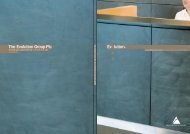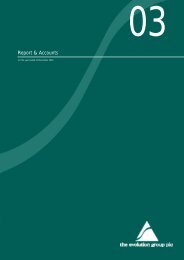Annual Report for the year ended 31 December 2008
Annual Report for the year ended 31 December 2008
Annual Report for the year ended 31 December 2008
Create successful ePaper yourself
Turn your PDF publications into a flip-book with our unique Google optimized e-Paper software.
1. aCCoUntinG PoliCies (CONTINuED)<br />
The issuance by <strong>the</strong> company to employees of its subsidiaries of an award<br />
over <strong>the</strong> company’s shares is treated as a capital contribution by <strong>the</strong><br />
company in its subsidiaries. This additional investment in subsidiaries<br />
results in a corresponding entry to shareholders’ equity. The additional<br />
capital contribution is based on <strong>the</strong> fair value of <strong>the</strong> awards issued<br />
allocated on a straight line basis over <strong>the</strong> relevant vesting period.<br />
Current and deferred income taxes<br />
current income taxes are computed on a basis of <strong>the</strong> tax laws enacted or<br />
substantially enacted at <strong>the</strong> Balance sheet date in <strong>the</strong> countries where <strong>the</strong><br />
company’s subsidiaries operate and generate income.<br />
Taxes are computed using <strong>the</strong> liability method, deferred income on<br />
temporary differences between <strong>the</strong> bases of assets and liabilities and <strong>the</strong>ir<br />
carrying amounts in Financial statements. The deferred income tax is not<br />
accounted <strong>for</strong> if it arises from initial recognition of an asset or liability in a<br />
transaction, o<strong>the</strong>r than a business combination, that at <strong>the</strong> time of <strong>the</strong><br />
transaction affects nei<strong>the</strong>r accounting nor taxable profit nor loss.<br />
Deferred income tax liabilities are recognised <strong>for</strong> all taxable temporary<br />
differences and deferred tax assets are recognised to <strong>the</strong> extent that it is<br />
probable that taxable profits will be available against which tax losses or<br />
deductible temporary differences can be utilised. such assets and liabilities<br />
are not recognised if <strong>the</strong> temporary difference arises from goodwill, negative<br />
goodwill or from <strong>the</strong> acquisition of an asset, which does not affect ei<strong>the</strong>r<br />
taxable or accounting income.<br />
Deferred income tax liabilities are recognised <strong>for</strong> taxable temporary<br />
differences arising on investments in subsidiaries, except where <strong>the</strong><br />
company is able to control <strong>the</strong> reversal of <strong>the</strong> temporary difference<br />
and it is probable that <strong>the</strong> temporary difference will not reverse in <strong>the</strong><br />
<strong>for</strong>eseeable future.<br />
notes to tHe FinanCial statements CONTINuED<br />
FOR THE YEAR ENDED <strong>31</strong> DECEMBER <strong>2008</strong><br />
84 The evoluTion Group plc AnnuAl reporT & AccounTs <strong>2008</strong><br />
Deferred income tax is charged or credited in <strong>the</strong> income statement, except<br />
when it relates to items charged or credited directly to equity, in which case<br />
<strong>the</strong> deferred tax is also dealt with in equity.<br />
The company is entitled to a tax deduction <strong>for</strong> amounts treated as<br />
compensation on exercise of certain employee share options under uK tax<br />
rules. As explained under “share-based plans” above, a compensation<br />
expense is recorded in <strong>the</strong> company’s income statement over <strong>the</strong> period<br />
from <strong>the</strong> grant date to <strong>the</strong> vesting date of <strong>the</strong> relevant options. As <strong>the</strong>re is a<br />
temporary difference between <strong>the</strong> accounting and tax bases, a deferred tax<br />
asset is recorded. The deferred tax asset arising is calculated by comparing<br />
<strong>the</strong> estimated amount of tax deduction to be obtained in <strong>the</strong> future (based<br />
on <strong>the</strong> company’s share price at <strong>the</strong> Balance sheet date) with <strong>the</strong><br />
cumulative amount of <strong>the</strong> compensation expense recorded in <strong>the</strong> income<br />
statement. if <strong>the</strong> amount of estimated future tax deduction exceeds <strong>the</strong><br />
cumulative amount of <strong>the</strong> remuneration expense, at <strong>the</strong> statutory tax rate,<br />
<strong>the</strong> excess is recorded directly in equity, against retained earnings.<br />
in accordance with <strong>the</strong> provisions of iFrs 2, no compensation charge is<br />
recorded in respect of options granted be<strong>for</strong>e 7 november 2002 or in<br />
respect of those options which have been exercised or have lapsed be<strong>for</strong>e 1<br />
January 2005. never<strong>the</strong>less, tax deductions have arisen and will continue<br />
to arise on <strong>the</strong>se options. The tax effects arising in relation to <strong>the</strong>se options<br />
are recorded directly in equity, against retained earnings.



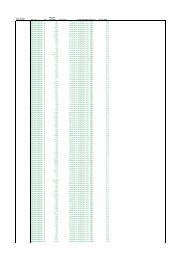
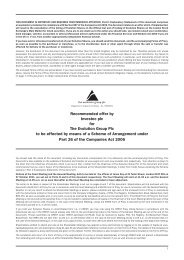
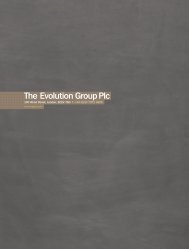
![2. Front continued [c87307] - The Evolution Group PLC](https://img.yumpu.com/19604468/1/184x260/2-front-continued-c87307-the-evolution-group-plc.jpg?quality=85)
